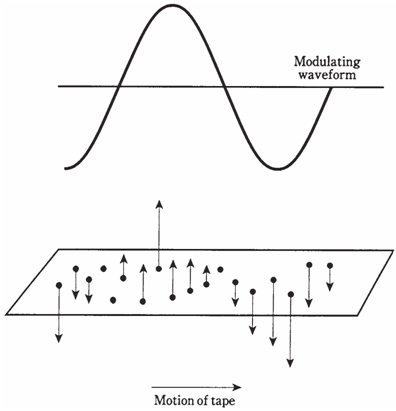Magnetic disk
The age of the personal computer has seen the development of ever-more-compact data-storage systems. It is one of the most versatile is the magnetic disk.
A magnetic disk can be either rigid or flexible. The disks are available in the various sizes. Hard disks store most of the data, and are found inside of computer units. Floppy disks are usually either 3½ or 5¼ inch in diameter, and can be inserted and removed from recording/playback machines called disk drives.
The principle of the magnetic disk, on the micro scale, is the same as that of the magnetic tape. The information is stored in digital form; which means that, there are only 2 different ways that the particles are magnetized. This results in perfect, error free storage.

Figure: On recording tape, particles are magnetized in a pattern that follows the modulating waveform.
On a larger scale, disk works differently than tape, simply due to the difference in geometry. On a tape, information is spread out over a long span, and some bits of data are far away from others. But on a disk, no 2 bits are ever farther apart than the diameter of the disk. This means that the data can be stored and retrieved quickly onto, or from, a disk than is possible with the tape.
A typical diskette can store an amount of digital information equivalent to a short novel. The same precautions should be taken when handling and storing magnetic disks, as are essential with magnetic tape.